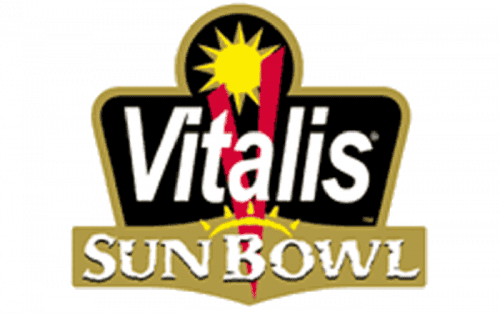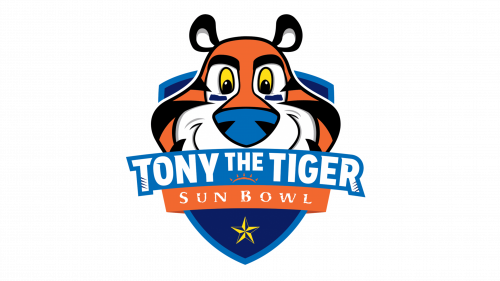In spite of the multiple modifications and updates introduced into the Sun Bowl logo since the first game was played in 1935, it has been consistent in one aspect. All the logotypes so far have alluded to the sun theme. In some cases, the logo has directly depicted the sun, while in others, at least the sunny gold shades were used in the design.
Meaning and history
The Sun Bowl, a cornerstone in college football’s postseason landscape, commenced its storied journey in 1935. This brainchild of the El Paso Kiwanis Club was envisioned to boost tourism in El Paso, Texas. Since then, it has evolved into one of America’s most enduring bowl games. Renowned for its festive atmosphere and storied past, the Sun Bowl has been a launching pad for future NFL stars, with many of its participants achieving subsequent professional acclaim. Hosted in the Sun Bowl Stadium, it consistently attracts teams predominantly from the Pac-12 and ACC conferences. As of my last update, the Sun Bowl remains a revered end-of-year event in the college football circuit, symbolizing a blend of athletic prowess, tradition, and community spirit.
What is Sun Bowl?
Rooted in tradition since 1935, the Sun Bowl epitomizes the enduring charm of college football in America. Held annually in El Paso, Texas, it ranks among the oldest collegiate bowl games. The event is a highlight of the college football season, drawing teams mainly from the Pac-12 and ACC conferences. It’s celebrated for showcasing emerging football talent and delivering an exhilarating experience to fans of the sport.
1963 – 1977

The initial Sun Bowl badge, created in 1963, featured an elegantly rounded shield with a stylized image of a sun on it. The logo was executed in a yellow and white color palette, with not a single contrasting accent. The upper part of the crest was drawn as an abstract crown with two slanted elements on each side and a rounded one with a white ornament, in the middle. The sun itself was drawn in line a solid yellow circle with twelve white triangular rays placed on it from the inside, creating a smaller solid circle in the center.
1978 – 1985

The redesign of 1978 made the Sun Bowl logo even simpler than it was. The two-shades color palette remained there, but with the yellow a bit lightened up. As for the composition, it was now based on a solid yellow sun, with the circle in the middle enclosed into a leaf-like frame, replacing the rays. Yeah of the ray-leaves featured a thin white pattern, which was balanced by the Internet circular outline, in white too. The center of the badge was taken by a white wordmark set in two levels on a plain yellow background and executed in a modest and traditional sans-serif typeface, in the uppercase.
1986 – 1988

A new color palette was adopted for the Sun Bowl visual identity in 1986. Now the badge features a half-circle shape, with a yellow, orange, and green background, decorated by a thin orange stripes pattern, coming horizontally through the whole yellow part of the logo. The cursive white “John Hancock” inscription was written over the orange segment, standing for the mountain chain silhouette, and the straight serif uppercase “Sun Bowl” also in white was set on the bottom green part of the insignia.
1989 – 1993

The logo was slightly refined in 1989. A few changes were made here. First of all the thin orange stripes from the upper part of the badge regrouped into a five-pointed star. Secondly, the word “Sun” was removed from the logo, and the “Bowl” got emboldened. And last, but not least change was about the color palette, which remained yellow-orange and green, but started using its lighter shades, which added more freshness and brightness to the whole composition.
1994 – 1995

Another redesign of the Sun Bowl visual identity was held in 1994. The new badge only stayed for one season and featured a similar composition to the previous emblem, but with straighter and bolder contours. The “Sun Bowl” inscription was now set on the upper part of the badge, set in an emboldened uppercase sans-serif typeface, in white and green. As for the bottom line of the logo, it now featured a light cursive “El Paso, Texas” in white, set over a solid green rectangle. The star pattern was replaced by a sun one with elongated rays coming out of the redrawn mountain landscape.
1996 – 1998

The stylized half-sun was redesigned with its rays getting square in 1996. As for the lettering part, it was now executed in a smooth and bold cursive and set along the bottom line of the sun, in green, with thin white and thick blue outlines. The upper part of the badge was now decorated by a large and strict logo of the bowl’s sponsor, Norwest. It was a green capital “N” formed by several solid squares separated by thin white lines, and a slanted sans-serif wordmark in blue capitals, written over the middle part of the “N”.
1999 – 2003

A completely new badge was created for the bowl in 1999. This is also when the new sponsor appeared. The badge featured a horizontally oriented rectangular shape and was executed in a deep blue and dark yellow color palette, with the silhouette of three horses carrying a cart, and a delicate half-sun symbol placed at the bottom, over a white serif “Sun Bowl” inscription in a rounded and bold serif typeface with an uneven surface of the capital letters. The solid red square of the sponsor’s logo was set on the top border of the badge and had a yellow two-leveled “Wells Fargo” inscription on it.
2004 – 2005

A black and gold smooth crest became the new official logo of the bowl for only one season in 2004. It was under the Vitalis sponsorship, so the largest, the black part of the shield was taken by its logo — a sharp narrowed “V” in dark red and a white wordmark in a slightly slanted sans-serif typeface. The upper part of the badge was embedded with a clean and sharp image of the sun, while its arched stylized drawing was set under the “Vitalis” inscription, and above the bold and uneven “Sun Bowl” lettering in white capitals, written over the wide gold part of the frame.
2006 – 2009

The rounded solid green badge replaced the Vitalis logo in 2006. It was a medallion with a horizontally stretched ribbon along its bottom part, a golden rugby ball, also horizontally oriented, in the center, a black and white “Brut” insignia in the center, and a part of the sharp stylized sun showing behind the rugby ball. As for the main logotype, it was written in its custom smooth typeface with its bold white capitals featuring a cracked and slightly erased pattern of the surface, with gray lines. The stylized sun, depicted by a bold yellow arched line and five small triangles pointing up above it, was set above the bottom letter line, on a plain green background.
2010 – 2019

The redesign of 2010 introduced a new bold blue crest with Hyundai as the sponsor of the bowl. The logo of the automaker was written in blue and set on a white background of a horizontally stretched ribbon, coming through the center of the badge. The upper part of the logo featured a yellow and white half of the rugby ball with sharp rays coming out of it. The bottom part contained a white “Sun Bowl” inscription, covered by the yellow arched stylized sun, which we could see on all latest versions.
2019 – Today

Tony the Tiger became the official sponsor of the bowl in 2019, and this is when the logo was redrawn again. It now features the iconic tiger caricature, placed on a classy blue crest and overlapped by an arched banner with a white wordmark on its bottom part. The top level of the banner was colored blue and contained the sponsor’s logotype, while the bottom part was colored orange and had the “Sun Bowl” written on it in white. Under the ribbons, a yellow and blue five-pointed star was placed on a plain blue background.









